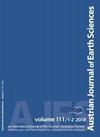北钙质阿尔卑斯山前的地质快照:奥伯穆斯TH-1,萨尔茨堡,奥地利
IF 1.1
4区 地球科学
Q2 Earth and Planetary Sciences
引用次数: 4
摘要
深热井Obermoos TH-1(总深度2468 m, 1990年)位于奥地利萨尔茨堡市西南边缘的北钙质阿尔卑斯山脉上白垩统Salzburg- reichenhall盆地内。岩性测井显示,基岩上方为冰川过深的萨尔扎克谷第四纪沉积物,厚度约200 m。第四纪充填体下覆厚约250 m,几乎水平分布的粗碎屑岩和泥灰岩属于上白垩统Salzburg-Reichenhall Gosau盆地。在456 ~ 2468 m处,经历了从塞诺曼期地层到上三叠统上白云岩的陡倾连续演替。这一演替被认为是北钙质阿尔卑斯山脉中部巴尤瓦尔推覆体的一部分,该推覆体在研究区域完全被蒂罗尔弧单元覆盖。深钻的新数据提供了(1)更新世山谷深部深度和充填的新信息,(2)对Bajuvaric推覆体复杂结构的新认识。我们还讨论了一个潜在的断层穿过萨尔茨堡-赖兴霍尔盆地,它是新生代因斯布鲁克-萨尔茨堡-阿姆斯泰滕断层系统的一部分。在更大的范围内,暴露在萨尔茨堡- reichenhall盆地南缘并可能覆盖在钻孔剖面上的tyrol单元必须与在萨尔茨堡市东南15公里和以东18公里的两个深钻孔中发现的平坦的tyrol推覆体相同(Vigaun 1和Vordersee 1)。本文章由计算机程序翻译,如有差异,请以英文原文为准。
A geological snapshot from the front of the Northern Calcareous Alps: Well Obermoos TH-1, Salzburg, Austria
The deep thermal well Obermoos TH-1 (total depth 2468 m, year 1990) was drilled within the Upper Cretaceous Salzburg-Reichenhall basin of the Northern Calcareous Alps at the southwestern edge of Salzburg city, Austria. The lithologic log shows c. 200 m thick Quaternary sediments of the glacially overdeepened Salzach Valley above bedrock. The Quaternary infill is underlain by c. 250 m thick, almost horizontally lying coarse clastics and marls, which belong to the Upper Cretaceous Salzburg-Reichenhall Gosau basin. From 456 m to 2468 m, a steeply dipping, more or less continuous succession from Cenomanian strata to Upper Triassic Hauptdolomit was encountered. This succession is considered being part of the Bajuvaric nappe of the central Northern Calcareous Alps, which is entirely overridden by units of the Tyrolic arc in the study area. The new data from the deep drilling provides (i) new information on depth and filling of the deeper parts of the Pleistocene valley and (ii) new insights into the complex structure of the Bajuvaric nappe. We also discuss a potential fault crossing the Salzburg-Reichenhall basin being part of the Cenozoic Innsbruck-Salzburg-Amstetten fault system. On a larger scale, the Tyrolic unit exposed in the southern margin of the Salzburg-Reichenhall basin and potentially overlying the borehole section must be the same as in the flat-laying Tyrolic nappe found in two deep drill holes, 15 km southeast and 18 km east of the City of Salzburg (Vigaun 1 and Vordersee 1).
求助全文
通过发布文献求助,成功后即可免费获取论文全文。
去求助
来源期刊

Austrian Journal of Earth Sciences
Earth and Planetary Sciences-Paleontology
CiteScore
3.10
自引率
0.00%
发文量
0
审稿时长
>12 weeks
期刊介绍:
AUSTRIAN JOURNAL OF EARTH SCIENCES is the official journal of the Austrian Geological, Mineralogical and Palaeontological Societies, hosted by a country that is famous for its spectacular mountains that are the birthplace for many geological and mineralogical concepts in modern Earth science.
AUSTRIAN JOURNAL OF EARTH SCIENCE focuses on all aspects relevant to the geosciences of the Alps, Bohemian Massif and surrounding areas. Contributions on other regions are welcome if they embed their findings into a conceptual framework that relates the contribution to Alpine-type orogens and Alpine regions in general, and are thus relevant to an international audience. Contributions are subject to peer review and editorial control according to SCI guidelines to ensure that the required standard of scientific excellence is maintained.
 求助内容:
求助内容: 应助结果提醒方式:
应助结果提醒方式:


